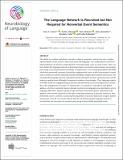| dc.contributor.author | Ivanova, Anna A | |
| dc.contributor.author | Mineroff, Zachary | |
| dc.contributor.author | Zimmerer, Vitor | |
| dc.contributor.author | Kanwisher, Nancy | |
| dc.contributor.author | Varley, Rosemary | |
| dc.contributor.author | Fedorenko, Evelina | |
| dc.date.accessioned | 2021-11-23T17:16:41Z | |
| dc.date.available | 2021-11-23T17:16:41Z | |
| dc.date.issued | 2021 | |
| dc.identifier.uri | https://hdl.handle.net/1721.1/138213 | |
| dc.description.abstract | <jats:title>Abstract</jats:title>
<jats:p>The ability to combine individual concepts of objects, properties, and actions into complex representations of the world is often associated with language. Yet combinatorial event-level representations can also be constructed from nonverbal input, such as visual scenes. Here, we test whether the language network in the human brain is involved in and necessary for semantic processing of events presented nonverbally. In Experiment 1, we scanned participants with fMRI while they performed a semantic plausibility judgment task versus a difficult perceptual control task on sentences and line drawings that describe/depict simple agent–patient interactions. We found that the language network responded robustly during the semantic task performed on both sentences and pictures (although its response to sentences was stronger). Thus, language regions in healthy adults are engaged during a semantic task performed on pictorial depictions of events. But is this engagement necessary? In Experiment 2, we tested two individuals with global aphasia, who have sustained massive damage to perisylvian language areas and display severe language difficulties, against a group of age-matched control participants. Individuals with aphasia were severely impaired on the task of matching sentences to pictures. However, they performed close to controls in assessing the plausibility of pictorial depictions of agent–patient interactions. Overall, our results indicate that the left frontotemporal language network is recruited but not necessary for semantic processing of nonverbally presented events.</jats:p> | en_US |
| dc.language.iso | en | |
| dc.publisher | MIT Press - Journals | en_US |
| dc.relation.isversionof | 10.1162/NOL_A_00030 | en_US |
| dc.rights | Creative Commons Attribution 4.0 International license | en_US |
| dc.rights.uri | https://creativecommons.org/licenses/by/4.0/ | en_US |
| dc.source | MIT Press | en_US |
| dc.title | The Language Network is Recruited but Not Required for Nonverbal Event Semantics | en_US |
| dc.type | Article | en_US |
| dc.identifier.citation | Ivanova, Anna A, Mineroff, Zachary, Zimmerer, Vitor, Kanwisher, Nancy, Varley, Rosemary et al. 2021. "The Language Network is Recruited but Not Required for Nonverbal Event Semantics." Neurobiology of Language, 2 (2). | |
| dc.contributor.department | Massachusetts Institute of Technology. Department of Brain and Cognitive Sciences | |
| dc.contributor.department | McGovern Institute for Brain Research at MIT | |
| dc.relation.journal | Neurobiology of Language | en_US |
| dc.eprint.version | Final published version | en_US |
| dc.type.uri | http://purl.org/eprint/type/JournalArticle | en_US |
| eprint.status | http://purl.org/eprint/status/PeerReviewed | en_US |
| dc.date.updated | 2021-11-23T17:12:11Z | |
| dspace.orderedauthors | Ivanova, AA; Mineroff, Z; Zimmerer, V; Kanwisher, N; Varley, R; Fedorenko, E | en_US |
| dspace.date.submission | 2021-11-23T17:12:12Z | |
| mit.journal.volume | 2 | en_US |
| mit.journal.issue | 2 | en_US |
| mit.license | PUBLISHER_CC | |
| mit.metadata.status | Authority Work and Publication Information Needed | en_US |
